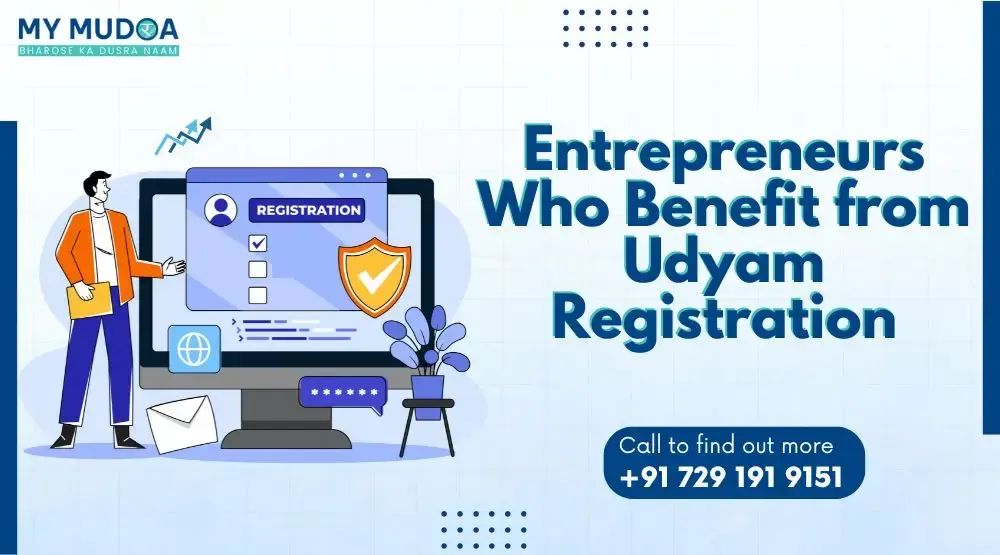
"See how Udyam Registration has helped entrepreneurs expand their businesses. Read real success stories of those who gained growth and opportunities!"

Published: 20 February 2025
Updated: 12 May 2025
As of early 2025, more than 6 crore businesses have registered on the Udyam portal. There is a wave of entrepreneurs gaining access to government benefits, easier loans, and a smoother path to growth.
Want to know why so many small business owners are talking about Udyam Registration for entrepreneurs? Let’s break down what Udyam Registration is, why it matters, and how you can use it to give your business a real edge.
It’s a simple online process that gives your micro, small, or medium enterprise (MSME) a unique number (government ID) and a certificate. This certificate is your ticket to a world of benefits, such as cheaper loans, easier access to government schemes for MSMEs, and protection from late payments.
Imagine you’re running a small textile shop. With Udyam Registration, you can apply for working capital loans at better rates, get paid on time owing to the Delayed Payments Act, and even win government contracts.
The good news?
The following are eligible to apply for Udyam registration:
Yes, startups can also register under Udyam! If you’re starting out, this is a smart first step.
Quick breakdown:
Wondering how to register on the Udyam portal? It’s easier than you think. Here’s how:
Go to the official portal: Udyam Registration
Click ‘New Registration’
Enter your Aadhaar and PAN card details
Fill in your business information (type, address, bank details, etc.)
Upload required documents (see below)
Submit and verify with OTP
Receive your Udyam certificate via email and SMS
Yes, registering on the official government portal is free. Beware of third-party sites charging fees.
Absolutely. Log in to the portal and update your info anytime as your business grows or changes.
Let’s get real. Here’s how actual entrepreneurs are using Udyam Registration to grow.
Rajesh was always chasing payments and struggling with cash flow. After Udyam Registration, he got a working capital loan at a lower rate and, thanks to the MSME Delayed Payments Act, his buyers had to pay within 45 days. Result? He boosted production by 20% in a year.
Meera’s startup couldn’t land big clients. After registering, she became eligible for government tenders reserved for MSMEs. Within six months, she won her first government project and grew her revenue by 50% in a year.
Ramesh didn’t know how to upgrade his workshop. Udyam Registration made him eligible for government-subsidized training and machinery grants. Two years later, his sales jumped 30%, and he even started selling online.
Here’s why Udyam Registration benefits entrepreneurs:
1. Cheaper Collateral-Free Loans: Get loans at interest rates up to 1.5% lower than normal. Many banks offer collateral-free loans up to ₹1 crore under the CGTMSE scheme.
2. Subsidies and Rebates:
3. Protection Against Delayed Payments: If a buyer delays payment beyond 45 days, you can charge interest at three times the RBI rate.
4. Easier Government Tenders: MSMEs get preference and are often exempt from the Earnest Money Deposit (EMD).
5. Electricity Bill Concessions: Lower power bills for registered MSMEs.
6. Stamp Duty and Registration Fee Waivers: Save money when acquiring property or registering assets.
7. Tax Benefits: Extended tax exemptions and MAT credit extension up to 15 years.
8. Priority Sector Lending: Banks are required to lend to MSMEs, making credit more accessible.
9. Access to Government Schemes for MSMEs: Priority in government procurement, marketing support, and export incentives.
10. Enhanced Credibility: Your business looks more trustworthy to banks, partners, and customers.
The government offers a range of targeted schemes for Udyam-registered businesses:
Most require you to have your Udyam Registration certificate. You apply directly through banks or government portals, often with minimal paperwork. Subsidies are credited to your account or reimbursed after you show proof of purchase or certification.
For example, if you buy a new machine for ₹20 lakh, you could get a subsidy of up to ₹7 lakh under CLCSS. If you register a new trademark, you can claim back half the registration cost.
Udyam Registration for entrepreneurs isn’t just a government formality. It’s a real, practical way to get better business loans, more clients, and a shot at government projects. It’s helped millions of businesses move from “just surviving” to “really thriving.” From subsidies and tax breaks to priority in tenders and protection from late payments, the benefits are real and immediate.
It’s your proof of MSME status. You can use it to apply for loans, claim subsidies, and participate in reserved tenders.
A GST number is not mandatory for MSME Udyam registration for businesses below an annual turnover threshold. However, it is necessary for taxable entities.
An individual is not eligible for Udyam MSME registration, as it is only for business entities.
💬 Comments
Leave a comment or ask a question!
Please Enter Your Name
Please Enter Your Email
Please Enter Your Phone
Please Write Your Comment